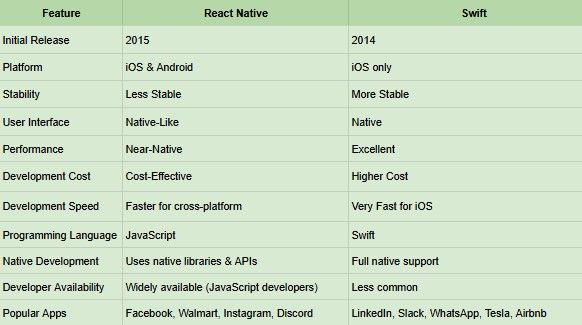Home
Services
Products
Projects
Who We Are
Blogs
Contact Us

React Native vs. Swift: Choosing the Optimal Mobile App Framework for Your Business
In today's competitive digital landscape, a mobile app is a vital tool for businesses to connect with their potential customers. With Android holding over 70% of the market share and iOS at nearly 28.8% (Statistics Q3 2023), selecting the right mobile app development framework is critical.
The ongoing debate between React Native and Swift presents a complex decision: native performance versus cross-platform flexibility. React Native, a versatile cross-platform framework, enables developers to build apps for both Android and iOS using a single codebase. Swift, Apple’s proprietary language, is designed exclusively for iOS applications.
Choosing between the two can significantly affect your app's success and your business’s bottom line. This article compares both technologies in depth, helping you decide the optimal solution for your project.
What is React Native?
React Native is a widely adopted JavaScript framework known for its cross-platform capabilities. It enables developers to create native-like apps for both iOS and Android. React Native also supports extensions to web and desktop apps, enhancing its flexibility.
Originally created by Facebook to overcome the limitations of HTML5 apps, React Native was released in 2015 and has since powered apps like Facebook, Instagram, and UberEats.
Key Advantages of React Native
- Enhanced Performance – Leverages native controls and APIs in separate threads, ensuring smooth operation.
- Modular Architecture – Breaks code into modules for better coordination and updates.
- Hot Reloading – Allows developers to view code changes in real-time, speeding up the development process.
- Streamlined App Updates – Supports OTA (over-the-air) updates, bypassing app store resubmissions.
- Cost-Effective Feature Integration – Easily integrates new features without full rewrites.
Limitations of React Native
- Not suitable for resource-heavy apps
- Platform maturity concerns due to ongoing updates
- Loosely-typed JavaScript can pose security risks
- Dependency on native modules for certain features
- Licensing & patent limitations under Facebook’s terms
What is Swift?
Swift is a modern programming language designed by Apple for building high-performance apps across iOS, macOS, watchOS, and tvOS.
Praised for its clean syntax, safety, and speed, Swift simplifies mobile development while offering the flexibility and efficiency required for enterprise-grade apps.
Key Advantages of Swift
- Rapid Development – Concise syntax and automatic memory management reduce development time.
- Scalability – Ideal for apps that require frequent expansion.
- Performance & Safety – Offers up to 40% better performance than Objective-C.
- Low Memory Usage – Loads libraries only when needed for improved efficiency.
- Objective-C Compatibility – Allows seamless integration with existing codebases.
- Full-Stack Capabilities – Can handle both frontend and backend iOS development.
Limitations of Swift
- Relatively new, with fewer third-party tools compared to older languages
- Smaller developer community
- Backward compatibility issues in older versions (mostly resolved in Swift 5)
- Limited developer availability in some regions
React Native vs. Swift: Head-to-Head Comparison

Key Differences Between React Native and Swift
- Performance: Swift delivers top-tier CPU performance; React Native performs well but may struggle with computation-heavy apps.
- User Interface: SwiftUI provides native UI elements. React Native uses JavaScript libraries but allows platform-specific UI tweaks.
- Stability: Swift handles complex visuals and tasks more reliably than React Native.
- Coding Speed: React Native offers faster cross-platform development. Swift is faster for pure iOS apps.
- Learning Curve: React Native is easier for JavaScript developers. Swift is beginner-friendly with tools like Swift Playgrounds.
- Developer Cost & Availability: React Native developers are easier to find. Swift development may cost more due to skill scarcity.
- Community Support: React Native has a large open-source ecosystem. Apple offers extensive Swift documentation and updates.
When to Choose Swift
Use Swift when:
- Your app is iOS-only
- You require high-performance features like complex animations or graphics
- You want deep integration with Apple’s ecosystem
- Memory optimization is a priority
When to Choose React Native
Use React Native when:
- You need a cross-platform app
- Rapid development and updates are important
- Your budget is limited
- Your team has JavaScript expertise
Let DEFX Guide You
Choosing between React Native and Swift can define your app’s success. At Defx, we specialize in both frameworks and help clients worldwide build robust, scalable, and high-performance mobile apps tailored to their business goals.
Ready to get started?
Contact Defx today to choose the right framework for your mobile app project.
FAQs
Is Swift or React Native better?
Swift is ideal for iOS-exclusive apps needing high performance. React Native is better for cross-platform development with faster time-to-market.
How does the learning curve differ between Swift and React Native?
Swift is easier for beginners with Apple's resources. React Native is easier for those with JavaScript/web backgrounds but may need adaptation for mobile contexts.
Which should I choose for building my app?
Choose Swift for performance-driven iOS apps. Choose React Native for cost-efficient cross-platform apps with wide user reach.
See More
Contact Us
Let’s make your Idea into Reality
Let's Talk
© Copyright DEFX. All Rights Reserved
GoodFirms ★ 4.2
Clutch ★ 4.2
Google ★ 4.2
